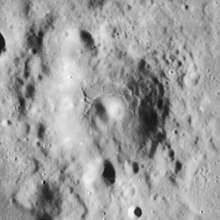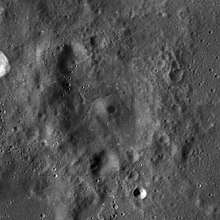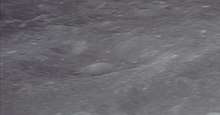Airy (lunar crater)
Airy is a lunar impact crater located in the southern highlands. It is named in honour of British astronomer George Biddell Airy.[1] It forms the southern-most member of a chain of craters consisting of Vogel, Argelander, and Airy. A little further to the south lies Donati. Airy has a worn, and somewhat polygonal rim that it broken at the northern and southern ends. It has an irregular floor and a central peak.
 Lunar Orbiter 4 image | |
| Coordinates | 18.1°S 5.7°E |
|---|---|
| Diameter | 37 km |
| Depth | 1.8 km |
| Colongitude | 354° at sunrise |
| Eponym | George B. Airy |

LRO WAC mosaic

Oblique view from Apollo 14

Vicinity of Airy, as viewed from the Bayfordbury Observatory
Satellite craters
By convention these features are identified on lunar maps by placing the letter on the side of the crater midpoint that is closest to Airy.
| Airy | Latitude | Longitude | Diameter |
|---|---|---|---|
| A | 17.0° S | 7.7° E | 13 km |
| B | 17.6° S | 8.5° E | 29 km |
| C | 19.3° S | 4.9° E | 34 km |
| D | 18.2° S | 8.5° E | 7 km |
| E | 20.7° S | 7.6° E | 38 km |
| F | 18.2° S | 7.3° E | 5 km |
| G | 18.7° S | 7.0° E | 25 km |
| H | 18.7° S | 5.8° E | 9 km |
| J | 19.0° S | 6.1° E | 4 km |
| L | 20.4° S | 7.5° E | 6 km |
| M | 19.2° S | 7.6° E | 1 km |
| N | 17.8° S | 8.2° E | 8 km |
| O | 16.7° S | 8.3° E | 5 km |
| P | 15.8° S | 8.4° E | 7 km |
| R | 19.6° S | 8.8° E | 7 km |
| S | 17.2° S | 9.4° E | 5 km |
| T | 19.2° S | 9.4° E | 40 km |
| V | 17.5° S | 9.2° E | 5 km |
| X | 18.9° S | 10.2° E | 4 km |
References
- "Airy". Gazetteer of Planetary Nomenclature. USGS Astrogeology Research Program.
- Andersson, L. E.; Whitaker, E. A. (1982). NASA Catalogue of Lunar Nomenclature. NASA RP-1097.CS1 maint: ref=harv (link)
- Bussey, B.; Spudis, P. (2004). The Clementine Atlas of the Moon. New York: Cambridge University Press. ISBN 978-0-521-81528-4.CS1 maint: ref=harv (link)
- Cocks, Elijah E.; Cocks, Josiah C. (1995). Who's Who on the Moon: A Biographical Dictionary of Lunar Nomenclature. Tudor Publishers. ISBN 978-0-936389-27-1.CS1 maint: ref=harv (link)
- McDowell, Jonathan (July 15, 2007). "Lunar Nomenclature". Jonathan's Space Report. Retrieved 2007-10-24.CS1 maint: ref=harv (link)
- Menzel, D. H.; Minnaert, M.; Levin, B.; Dollfus, A.; Bell, B. (1971). "Report on Lunar Nomenclature by the Working Group of Commission 17 of the IAU". Space Science Reviews. 12 (2): 136–186. Bibcode:1971SSRv...12..136M. doi:10.1007/BF00171763.CS1 maint: ref=harv (link)
- Moore, Patrick (2001). On the Moon. Sterling Publishing Co. ISBN 978-0-304-35469-6.CS1 maint: ref=harv (link)
- Price, Fred W. (1988). The Moon Observer's Handbook. Cambridge University Press. ISBN 978-0-521-33500-3.CS1 maint: ref=harv (link)
- Rükl, Antonín (1990). Atlas of the Moon. Kalmbach Books. ISBN 978-0-913135-17-4.CS1 maint: ref=harv (link)
- Webb, Rev. T. W. (1962). Celestial Objects for Common Telescopes (6th revised ed.). Dover. ISBN 978-0-486-20917-3.CS1 maint: ref=harv (link)
- Whitaker, Ewen A. (1999). Mapping and Naming the Moon. Cambridge University Press. ISBN 978-0-521-62248-6.CS1 maint: ref=harv (link)
- Wlasuk, Peter T. (2000). Observing the Moon. Springer. ISBN 978-1-85233-193-1.CS1 maint: ref=harv (link)
External links
| Wikimedia Commons has media related to Airy (lunar crater). |
- Airy at The Moon Wiki
- Wood, Chuck (February 10, 2008). "Airy Swirl". Lunar Photo of the Day.
This article is issued from Wikipedia. The text is licensed under Creative Commons - Attribution - Sharealike. Additional terms may apply for the media files.
